SEA TURTLES OF THE CENTRAL MEDITERRANEAN
Only one of five Mediterranean species of sea turtle - the Loggerhead
Turtle - is commonly encountered in Maltese waters, though a number of
Leatherback Turtle specimens have been captured in the last decades. The
other three Mediterranean species are known only from single specimens
captured throughout the last century. The identification of the two main
Maltese species is simple since they are markedly different. The other
species can be differentiated from the Loggerhead Turtle on the basis of
the shield arrangement of the carapace and plastron, and the scale patterns
of the head.
IDENTIFICATION OF MALTESE SEA TURTLES
1a. - Carapace covered with large plates ........................................
Fam.:
Chelonidae (2)
1b. - Carapace covered with leathery skin composed of a mosaic of
very small plates .......................................................................
Fam.: Dermochelyidae: Leatherback Turtle
2a. - Carapace with four pairs of costal shields ..............................................................
3
2b. - Carapace with five or more pairs of costal shields .................................................4
3a. - Dorsally, head has one pair of prefrontals ..........................................
Green
Turtle
3b. - Dorsally, head has two pairs of prefrontals ..................................
Hawksbill
Turtle
4a. - Lateral bridge between carapace and plastron with three inframarginals
.................................................................................................................Loggerhead
Turtle
4b. - Lateral bridge between carapace and plastron with four inframarginals
each with a hindpiece ............................................................................................Kemp's
Ridley Turtle
SYSTEMATIC LIST
Class: REPTILIA
Order: CHELONIA
Family: DERMOCHELYIDAE Fitzinger, 1843
Genus: DERMOCHELYS Blainville, 1816
Dermochelys coriacea Linnaeus, 1766
Leatherback Turtle
maltese: Fekruna Sewda
Geographical range: This turtle is truly pelagic species
much given to wandering great distances at sea. It has been described as
having a temperate range with tropical nesting habits indicating its wide
distribution range. It is thus found in the Atlantic, Pacific and Indian
Oceans, besides the Mediterranean. It is a critically endangered species.
It has been on a number of occasions captured from around Maltese shores,
first recorded in 1970 with 13 specimens being noted during the following
decade (LANFRANCO,1983; SAVONA-VENTURA,1978/1979; DEPT. OF ENVIORNMENT,1992a;
BALDACCHINO & SCHEMBRI,1993)
Biological characteristics: Colour black or slaty black above,
sometimes very dark brown with scattered whitish or pinkinsh felcks. Ventral
surface white or pinkish white, with irregular black markings. Carapace
strongly tapering behind, with five or seven keels or ridges lengthwise
along the back. Carapace skin leathery with no scutes of tortoise-shell.
Paddle-spahed limbs devoid of claws. Largest of turtles, carapace size
up to 3 meters in length.
Family: CHELONIIDAE Gray, 1825
Genus: CARETTA Rafinesque, 1814
Caretta caretta Linnaeus, 1766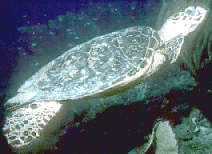
Loggerhead Turtle
maltese: Fekruna Komuni
Geographical range: The Loggerhead is a highly adaptable
animal much given to wandering and has a world-wide distribution.
It is commonly recorded in the Mediterranean and is often noted
in Maltese waters, commonly in Spring and from August to November (ADAMS,1870;
MEDLYCOTT,1870; GULIA,1873a; GULIA,1890/1913; DESPOTT,1913/1915; LANFRANCO,1955/1957;
SAVONA-VENTURA,1978/1979; DEPT. OF ENVIORNMENT, 1992a; BALDACCHINO &
SCHEMBRI,1993). The species was in the past reported to breed on Maltese
sandy beaches (GULIA,1890, DESPOTT,1915).
Biological characteristics: Colour reddish-brown above, the
scutes streaked with darker brown in the younger specimens. Ventral surface
yellowish. Oval elongated shell, being distinctly longer than broad. Five
costal scutes on either side, though aberrations may be found with four
scutes. Plastron is joined to the carapace by three large inframarginals.
Large head, with five prefrontals in front of a large frontal. Paddle-shaped
limbs with one or two claws. Size up to about 2 meters long carapace.
Genus: CHELONIA Latreille, 1801
Chelonia mydas Linnaeus, 1758
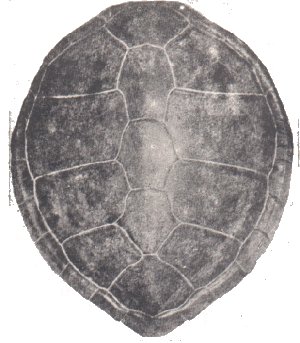
Green Turtle
maltese: Fekruna Harda
Geographical range: This species is found in the Atlantic
Ocean and the Mediterranean (mainly eastern part) where it breeds, on sandy
shores of Turkey, Cyprus and Israel. One specimen was captured about one
mile from the Grand Harbour in 1929 (DESPOTT,1930/1930a; LANFRANCO,1957;
SAVONA-VENTURA,1978/1979; DEPT. OF ENVIORNMENT,1992a; BALDACCHINO &
SCHEMBRI,1993)
Biological characteristics: Colour light to dark brown, sometines
with a tinge of olive. Scutes marked with darker markings. Lower surface
whitish to yellowish. Carapace with four costal scutes on either side,
the scutes never overlapping. Single pair of elongated prefrontal scutes
on the head. Limbs with one curved thick blunt claw on first digit. Size
may reach a maximum carapace length of 110 cm. The specimen captured in
Malta had a carapace length of about 21/2 feet (~75cm).
Genus: LEPIDOCHELYS Fitzinger, 1843
Lepidochelys kempii Garman, 1880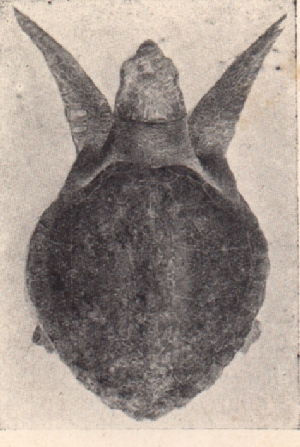
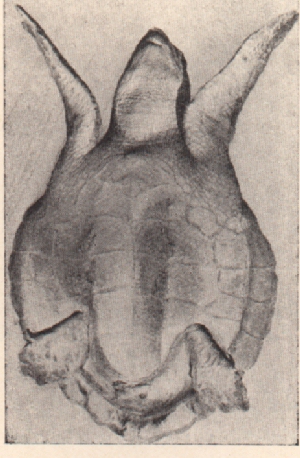
Kemp's Ridley Turtle
maltese: Fekruna ta' Kemp
Geographical range: This species is found in the Atlantic,
chiefly in the western shores of the Gulf of Mexico where it breeds. There
are about 18 records in European waters, mainly the Atlantic European coasts.
It is very rarely found in the Mediterranean, the only confirmed sprecimen
being the one from Malta. One specimen (now preserved in the Maltese Museum
of Natural History) was captured in Maltese waters about one mile from
the Grand Harbour in 1929 (SAVONA-VENTURA,1978/1979; BRONGERSMA & CARR,1983;
BALDACCHINO & SCHEMBRI, 1993)
Biological characteristics: Dark grey, greyish brown, sometimes
nearly blackish or olive green above. Scutes marked with slightly darker
streaks. Ventral surface whitish to pale greenish yellow. Five costal scutes
on either side, four inframarginals on either side, each of which is perforated
by a pore. Shell relatively very broad, and carapace may be slightly broader
than long. A small turtle, carapace up to one metre long. Specimen from
Maltese waters was 29.4 cm long and 28.2 cm wide.
Genus: ERETMOCHELYS Fitzinger, 1843
Eretmochelys imbricata Linnaeus, 1766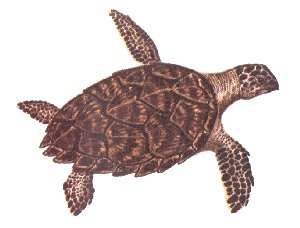
Hawksbill Turtle
maltese: Fekruna Mtektka
Geographical range: The Hawkbill is found circumglobally
within the tropical range. It is occasionally captured in the Mediterranean.
One specimen has been captured about five miles to the east of Gozo (BALDACCHINO
& SCHEMBRI, 1993).
Biological characteristics: Carapace amber, with streaks
and markings of reddish-brown, blackish-brown and yellow. Lower surface
yellowish with possibly some black blotches. Elongated carapace with four
costal scutes on either side which overlap markedly. Two pairs of prefrontal
scutes on the head. Carapace length up to about one metre.

 References
References






